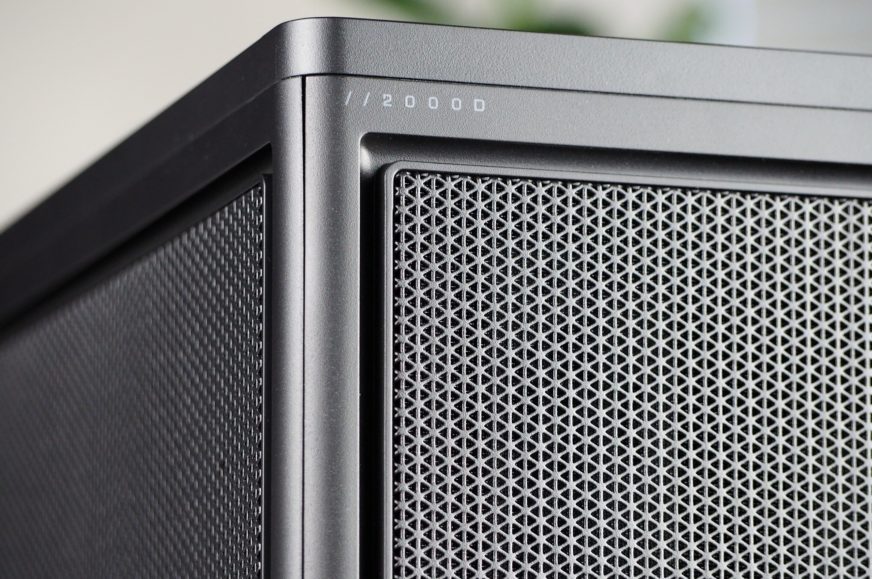Interior
Although the choice of components for SFF cases is often limited to a certain size, this is not the case with the Corsair 2000D Airflow. Not when it comes to a graphics card or CPU cooler. Aside from the fact that this case only takes up a very small area on the desk/ground, it can also impress with huge perforations on each side. We’ll break down the sum of all the positives and negatives in this review, which traditionally includes cooling tests as well.
Interior
Hardware is mounted into the case through the right side, where behind the side panel there is also a bracket for fans or a liquid cooler radiator. You can place three 120 mm fans or two 140 mm fans here. Or you can use the bracket to mount a 280/360 mm liquid cooler radiator. The bracket will firmly hold whatever you mount on it. Its thickness is 0.75 mm.
Once the bracket (for fans/radiator) is removed, you get right to the main side of the tray. You can only fit a Mini-ITX motherboard on it, which is to be expected given its size. All around the motherboard compartment you can notice a large number of small hooks for single-use zip ties. This allows you to take advantage of different paths and ways to make your cable management as efficient as possible.
Directly under the ceiling is a removable drawer for the power supply. This fits SFX or SFX-L formats up to 130 mm. Two 2.5″ storage units can be placed on the drawer using a bracket. Only one such bracket is supplied with the case, so you will have to buy a second one separately if necessary. The bad news is that I haven’t found this bracket offered on the official Corsair website yet.
As with the motherboard compartment, you have the option of fixing cabling pretty much anywhere on the power supply drawer.
One 2.5″ storage unit can also be mounted under the ceiling using the screws from the accessories. The number “2” is the actual maximum amount that the case can hold. When the bracket for the second position on the drawer goes on sale, the case will be able to accommodate three 2.5″ storage units.
Although the case is smaller in size, you can also fit large 3-slot models of graphics cards into it. The only limit is their maximum length, which is 365 mm. When using a 1-slot card, you will have enough space left on the back panel of the case to fit 2×120 mm fans. You can also swap the fans for a thin 120/240mm liquid cooler radiator.
There are also cable management hooks on the back of the tray. There’s even 10mm of space for some thinner cables. The tray is 0.7mm thick, while the “support” perimeter plates are up to 1.2mm thick. I have to admit that even though the case is more holey than solid, the sturdiness of the case is of a high standard.
For completion, the first thing I would mention is that Corsair has an incorrect figure in the parameters about the maximum height of a tower cooler for the processor. I was able to fit the Fuma 2 rev. B cooler into the advertised 90mm without any difficulty. This one is 154.5mm tall, with about 15mm left over (not including the side fan/radiator bracket).
Installing the components into the case was not the easiest but not the most complicated either. It was something in between. I was most frustrated when I remembered that I needed to plug one more thing into the motherboard when almost all the rest was already mounted. When you need to redo something inside the case further through a build, it’s not going to be a walk in the park.
For cable management, you have plenty of hooks on each side, but to get the ideal placement you need to think everything through and the execution is a bit more work. I didn’t spend much time on it, but it can be done without any great precision as you can see. After all, with the panels closed you can hardly see inside the case at all.
The space at the back of the case for external cabling (such as cables for monitors, mouse, keyboard, etc.) is not ideal. The cabling has to be bent quite a bit. For less strain on the cables, I chose the hole at the bottom as an outlet for handling external cabling.
- Contents
- Exterior
- Interior
- Test methodology
- CPU and GPU cooling tests
- Motherboard cooling tests
- SSD cooling tests and under-ceiling temperature
- Conclusion






















This is another example of stock fans being installed the wrong way. The case fans running as exhaust would help GPU thermals instead of worsening it.
Of course. The strong disproportion of intake to exhaust fans is probably done for aesthetics (through a glass front or perforated screen the light shining through “looks nice”). Well, you make what’s in demand, and when cooling efficiency is far behind how the build looks visually in the priority list… Strong positive pressure is still usually defended by less pollution due to dust, but I don’t know. I’m a bit worried that over time there might not be an alternative in which you can move those fans to different (exhaust) positions according to how they make sense from a functional standpoint.